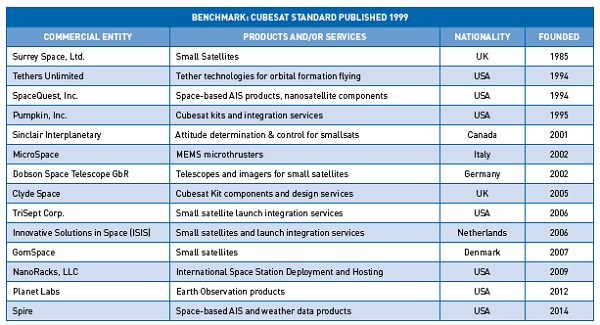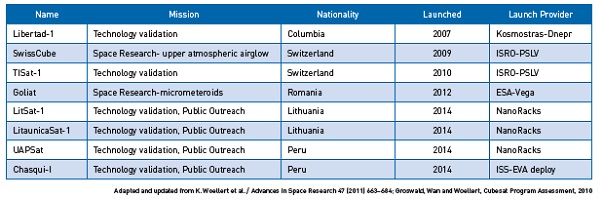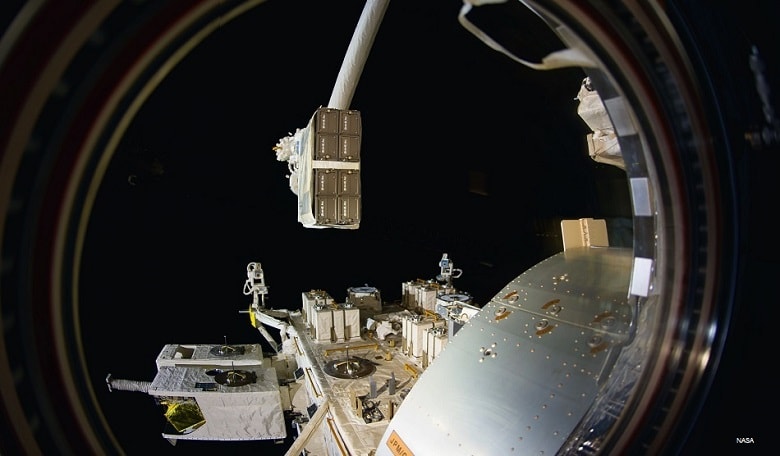Revolutions, especially in industry, sometimes begin quietly. The trend towards smaller and less expensive space hardware is no exception. Yet however quiet, the concept of downsizing hardware is dramatically altering how the business of space is performed.
Looking for a starting line, one can turn to the year 1959. At the California Institute of Technology Richard Feynman presented a lecture entitled “There’s Plenty of Room at the Bottom.”
The legendary physicist challenged scientists and engineers to win a prize of $1,000 USD of his own money to create a working motor made up of atoms. Many credit this talk as launching the very concept of nanotechnology. But at the time, both Feynman’s vision and the radical evolution of manufacturing onto the nano level fell on deaf ears.
The 1950s and 1960s were a time when the exploration of space was dependent on monster rockets and huge satellites. Think of the American Saturn or Atlas, the French Ariane and the Russian N1 and Proton vehicles.
In that sense, the space industry reflected the times. These rockets came of age at a time when everything in society was gigantic. Cars from Detroit had huge fins, radios a meter high were part of the living room furniture and the computers of the 1950s filled an entire room. Big was cool.
A stubborn space industry
Over the coming decades, the miniaturisation of electronics disrupted many industries. Radios and computers shrunk in size and cost, but space exploration remained stubbornly reliant on the tried and true.
Change came slowly. Today the use of manufacturing practices from other industries is dramatically changing space utilisation and, soon enough, national space exploration.
Yet again we can point to the American West Coast as the starting point of these changes.
Recognising the huge barrier for aerospace engineering students to take part in actual space programs, Jordi Puig-Suari of California Poly-technic Institute (Cal Poly) and Robert Twiggs of Stanford University introduced the CubeSat specification (a type of nanosatellite), a 10-cm cube (known as 1-U in size) with mass of no more than 1.3 kg – a satellite no larger than the palm of one’s hand.
The concept was ignored by the industry, but a generation of engineering students began asking the simple question: “Why should space manufacture and design be different than that of personal computers or robots or any other terrestrial engineering unit?”
Jump a decade and today nanosatellite technology is a disruptive force changing operational space programs in fields as diverse as earth observation and soon enough, interplanetary missions.
A 1959 lecture by Richard Feynman may have launched the concept of nanotechnology
For the first time in the space exploration industry both the speed of a program development and the cost are dropping when allowed to be undertaken using commercial methods and practices. Government space agencies from NASA to ESA are providing funding for educational CubeSat ventures, the American Department of Defense is funding sophisticated CubeSat and small sat constellations and commercial companies are raising funds to launch commercial CubeSat constellations.
Moore’s Law
What precisely lies at the heart of this satellite revolution? It is not just the size of the satellite itself, but reliance on open sources of technology, miniaturization of components and the continued adherence to Moore’s Law, which states that the over the history of computing hardware, the number of transistors in a dense integrated circuit doubles approximately every two years. What works on the earth apparently also works in the vacuum of space.
 TAB LE 1, SELECTED SMALL SATE LLITE/ NANOSATE LLITE SERVICE AND COMPONENT PROVIDERS
TAB LE 1, SELECTED SMALL SATE LLITE/ NANOSATE LLITE SERVICE AND COMPONENT PROVIDERS
The changes started in the educational world before adoption by government and industry. To date, close to 100 educational institutions around the world are participating in the CubeSat revolution.
The reduced cost is driving innovation in supporting technologies, including telecommunications, (opto) electronics, materials, sensors, fluidics, and instrumentation.
CubeSat developers can choose from a variety of components to meet mission requirements and avoid costly and time-consuming in-house development. Further, open source markets are well documented to have generally faster innovation cycles than closed proprietary technologies. The nanosatellite community of developers utilizes open source technologies because they are freely available and offer new capabilities quicker than commercial providers.
$5,000 and up
What are the costs? For the simplest Cubesat package, one can expect to spend $5,000 and up.
The launch may be provided for free by ESA and NASA. Commercial companies like NanoRacks, LLC and Kosmotros and intermediaries like Spaceflight Services and ISIS charge from $85,000 and up, depending on the size of the Cubesat.
Still expensive, but at NanoRacks customers include high schools (Valley Christian High School in San Jose, California) as well as sophisticated CubeSats from commercial and government customers.
A NanoRacks deployer high above earth
At the top end, rumour has it that one aerospace company charged the US government close to $10 million for a series of CubeSats. But that lofty price level is hardly the norm. More realistic are the robust Cubesats from Denmark’s GomSpace and the kits of Scotland-based Clyde Space and Pumpkin in America.
Table 1 shows the international nature of the resulting marketplace supporting CubeSats. It’s hard to realise that prior to the emergence of the CubeSat standard, Surrey Space, Ltd. and its class of satellites down to about 100 kg, were considered the smallest useful satellite.
Today a new standard is the “three unit” (3U) Planet Labs’ imaging CubeSat for Earth Observation data products, and more recently Spire, which plans to offer maritime location-based and weather data product services from its own CubeSat constellation.
As in any commercial marketplace, a robust ecosystem has emerged.
The deployer releasing the CubeSats in orbit
Companies like Pumpkin and Clyde Space offer packaged kits. TriSept and ISIS offers services and NanoRacks has introduced commercial CubeSat deployment from the International Space Station. And the capital being invested is at a tipping point, with Planet Labs having recently completed a $90 million USD round of financing, with an estimated company valuation of $250 million USD.
NanoRacks technology is cheap enough for some high schools to use
With this sort of capital, Planet Labs can deploy hundreds of CubeSats via different launch vehicles and via the Space Station still at a small fraction of the cost of a standard earth observation mission. And should one deployment fail, should one launch vehicle not reach orbit, there are waves of next generation Planet Labs’ CubeSats, called Doves, ready to “fly.”
Time speeds up
Changing also is the time required from design to deployment. For both the DoD world and the commercial marketplace, time is of the essence.
Case in point, a customer using NanoRacks’ CubeSat deployment service from the International Space Station developed a three unit CubeSat with an experimental communications payload from concept to flight hardware delivery in just 92 days.
The first rockets came of age when society worshipped gigantism
Contrast this with the two-year schedule typical for a geostationary communications satellite, or perhaps five or more years for space research missions. Of course, the CubeSats do not deliver the results of a “big bird,” but throw in the fact that a company can launch multiple times a year and each time with more sophisticated components (per Moore’s Law) and learn from the mistakes of the past deployment, and one begins to see the power of this innovation.
The CubeSat revolution has also dramatically lowered the barrier for countries to participation in space utilisation. No longer does a small nation have to confront the huge costs of the traditional national space government agency. Table 2 shows some examples of new national players in space utilization:
Time is of the essence for both governments and commercial markets
Of all the “space firsts” we have enjoyed at NanoRacks, none gives us greater enjoyment that having played a role in propelling Lithuania and Peru into the “space business.” And we expect more first time nations in the years to come.
Launch vehicles
A close-up view of the NanoRacks CubeSat deployer in action
The growth of CubeSat constellations is fuelling a new generation of would-be dedicated launch vehicles. Right now, NASA and ESA support dozens of educational CubeSats on several different vehicles. Commercially, one can deploy on Russian and Indian vehicles. And the European Vega and Soyuz also offer flight opportunities. Meanwhile, NanoRacks’ deployment program from the International Space Station, according to Planet Labs, allowed us to jump at least two years in their development.
But the future suggests even more opportunity for small satellite launches. Companies ranging from Virgin Galactic to XCOR to new entrants such as Rocket Lab in New Zealand are pouring hundreds of millions of into developing standalone dedicated CubeSat and Small Sat launches.
Explosive growth
We believe that the success of a majority of the would-be dedicated CubeSat vehicles will usher in a period where flight opportunities are almost like commodities, where profit margins are thin and the rewarding game belongs to the owners of payloads. The result is explosive growth in the utilisation and exploration of the frontier of space.
Nothing speaks to this more than the announcements by Richard Branson at Virgin and Elon Musk of SpaceX that they are funding hundreds of satellites, to extend the Internet backbone to low Earth orbit and other commercial projects. The response? Google’s investment of a billion dollars into the marketplace.
 SELECTED COUNTRIES WHOSE FIRST SATE LLITE IS A NANOSATE LLITE OR CUBESAT
SELECTED COUNTRIES WHOSE FIRST SATE LLITE IS A NANOSATE LLITE OR CUBESAT
The revolution in how the industry builds and deploys satellites has to date remained focused on the small satellites. But with a rush of new commercial players the lessons learned may well spill over into the larger satellite industry, interplanetary scientific missions and even how we operate our future space platforms both in low Earth orbit and beyond.
Soon enough payloads that are commercially manufactured, rapidly maximizing advances in technology, open source and standardized platforms will be the norm. That may be the true legacy of the CubeSat revolution.














